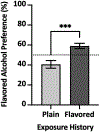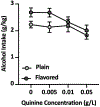Prior experience with flavored alcohol increases preference for flavored alcohol but flavor does not influence binge-like drinking behavior in mice
- PMID: 37336280
- PMCID: PMC10527159
- DOI: 10.1016/j.physbeh.2023.114275
Prior experience with flavored alcohol increases preference for flavored alcohol but flavor does not influence binge-like drinking behavior in mice
Abstract
Background: Binge drinking can lead to various negative consequences and in non-experimental settings, alcohol usually contains flavoring, which may promote increased binge drinking. Preclinical models of binge-like drinking have been well established, however, the influence of flavor on alcohol preference and binge-like drinking has not been fully explored.
Methods: Male and female C57BL/6 J mice were tested via two-bottle choice with alcohol flavored with different concentrations of unsweetened Cherry flavor Kool-Aid and water. Next, mice were tested for preference for flavored alcohol over plain alcohol. Consumption of flavored alcohol versus water was examined over 48 h. Binge-like drinking with flavored alcohol was validated via drinking in the dark (DID). A separate cohort of mice underwent chronic DID for 6 weeks with either flavored or plain alcohol. After chronic DID, mice were then tested for preference for flavored versus plain alcohol and then alcohol consumption despite adverse effects was examined using the quinine adulteration test.
Results: The 0.1% Kool-Aid concentration was chosen to use for further testing based on intake. Mice preferred Kool-Aid flavored alcohol over plain alcohol after the concentration test, but mice with no prior exposure to plain or flavored alcohol preferred plain over flavored alcohol. Throughout all initial testing, female mice showed increased alcohol intake compared to male mice. Both male and female mice showed binge-like drinking of flavored alcohol, with females having higher intake and blood alcohol levels. Kool-Aid flavor did not increase alcohol intake during chronic binge-like drinking. Previous exposure to flavored alcohol during DID increased the preference for flavored alcohol over plain alcohol but did not influence alcohol consumption despite adverse effects.
Conclusion: The present study indicates that prior experience with flavored alcohol increases preference and intake, suggesting an effect of learned safety from neophobia. However, flavor does not impact binge-like alcohol consumption or alcohol drinking despite negative consequences. Additionally, the current study shows that female mice will consume more flavored alcohol than males, similar to findings from other alcohol studies.
Keywords: 2BC; DID; Ethanol; Learned safety; Neophobia.
Copyright © 2023 Elsevier Inc. All rights reserved.
Conflict of interest statement
Declaration of Competing Interest None.
Figures







Similar articles
-
Sex differences in the synergistic effect of prior binge drinking and traumatic stress on subsequent ethanol intake and neurochemical responses in adult C57BL/6J mice.Alcohol. 2018 Sep;71:33-45. doi: 10.1016/j.alcohol.2018.02.004. Epub 2018 Mar 3. Alcohol. 2018. PMID: 29966824 Free PMC article.
-
Absence of compulsive drinking phenotype in adult male rats exposed to ethanol in a binge-like pattern during adolescence.Alcohol. 2019 Sep;79:93-103. doi: 10.1016/j.alcohol.2019.01.006. Epub 2019 Jan 18. Alcohol. 2019. PMID: 30664983 Free PMC article.
-
Home cage voluntary alcohol consumption increases binge drinking without affecting abstinence-related depressive-like behaviors or operant responding in crossed high alcohol-preferring mice (cHAPs).Alcohol. 2024 May;116:9-19. doi: 10.1016/j.alcohol.2023.10.001. Epub 2023 Oct 13. Alcohol. 2024. PMID: 37838352 Free PMC article.
-
"Drinking in the dark" (DID) procedures: a model of binge-like ethanol drinking in non-dependent mice.Alcohol. 2014 May;48(3):235-41. doi: 10.1016/j.alcohol.2013.08.005. Epub 2013 Oct 29. Alcohol. 2014. PMID: 24275142 Free PMC article. Review.
-
Scheduled access alcohol drinking by alcohol-preferring (P) and high-alcohol-drinking (HAD) rats: modeling adolescent and adult binge-like drinking.Alcohol. 2014 May;48(3):225-34. doi: 10.1016/j.alcohol.2013.10.004. Epub 2013 Oct 31. Alcohol. 2014. PMID: 24290311 Free PMC article. Review.
References
Publication types
MeSH terms
Substances
Grants and funding
LinkOut - more resources
Full Text Sources

